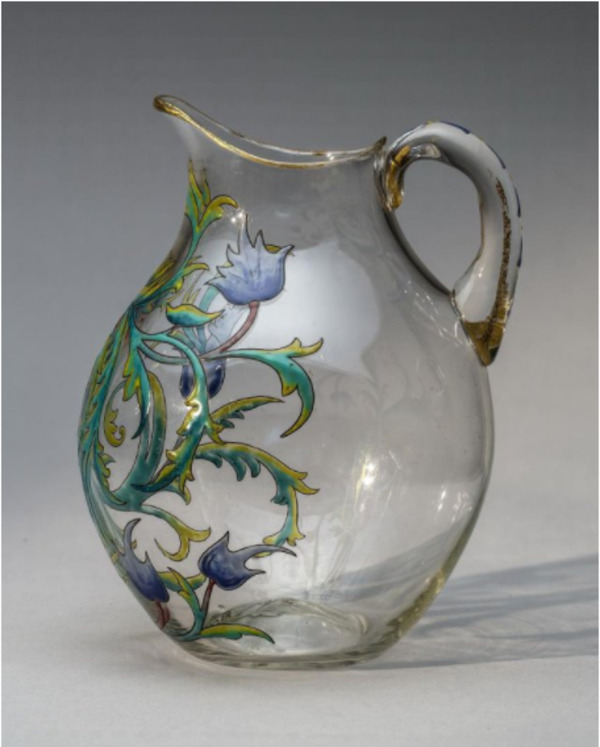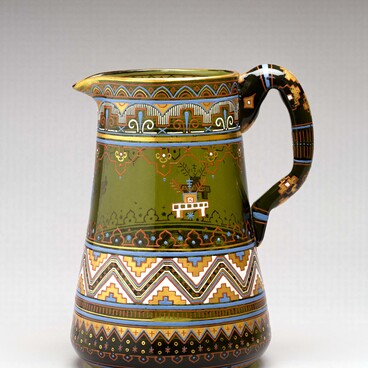The Russian style is a complicated phenomenon of Russian art. It is a part of a powerful socio-cultural process inherent in both Russia and European countries throughout the 19th century — the movement for the revival and formation of national culture — and includes several directions.
At the end of the 19th century the Russian-Byzantine style was replaced by the so-called Kremlin style: the theory of the official nationality saw the origins of national culture not only in the pre-Mongol period of Russian history, it connected them with a later time — the period of formation and prosperity of the Moscow state, which was strongly influenced by the Italian Renaissance.
The goblet and jug of the Imperial Glass Factory, presumably created from sketches by master Ivan Murinov, clearly show the difference between the pretentious style of antiquity and the sophistication inherent in the Kremlin style. Ivan Murinov headed two main factory’s workshops — a painting workshop and a carving and grinding workshop. In addition, he created stained glass windows. For example, he participated in the restoration of the altarpiece of St. Isaac’s Cathedral, and in the 1880s he was engaged in the restoration of stained glass windows in the church of St. Alexander Nevsky in Peterhof Alexandria.
The color scheme of enamel painting of the Kremlin style objects is more restrained in comparison with the Russian-Byzantine style, it is dominated by greenish tones. The floral decoration corresponds to the ornamental motives of the Kremlin cathedrals of the 16th — 17th centuries. Hence, there are ornaments of lush curls and rosettes, lilies on curved stems on glass items. At the same time, the traditionally Russian form of the jug is combined with the painting, which refers to the Italian Renaissance. Among the flowers and leaves of the ornament, you can see a fairy-tale character — the hob.
The unusual shape of the Imperial Factory’s goblet resembles a cornucopia — a source of wealth and abundance in ancient mythology. Traditionally, it is filled with flowers or fruits, they are imitated by an ornament painted with enamel on transparent glass. The transparent glass from which the objects are made also refers us to European traditions, where it was widespread already in the Renaissance.
At the end of the 19th century the Russian-Byzantine style was replaced by the so-called Kremlin style: the theory of the official nationality saw the origins of national culture not only in the pre-Mongol period of Russian history, it connected them with a later time — the period of formation and prosperity of the Moscow state, which was strongly influenced by the Italian Renaissance.
The goblet and jug of the Imperial Glass Factory, presumably created from sketches by master Ivan Murinov, clearly show the difference between the pretentious style of antiquity and the sophistication inherent in the Kremlin style. Ivan Murinov headed two main factory’s workshops — a painting workshop and a carving and grinding workshop. In addition, he created stained glass windows. For example, he participated in the restoration of the altarpiece of St. Isaac’s Cathedral, and in the 1880s he was engaged in the restoration of stained glass windows in the church of St. Alexander Nevsky in Peterhof Alexandria.
The color scheme of enamel painting of the Kremlin style objects is more restrained in comparison with the Russian-Byzantine style, it is dominated by greenish tones. The floral decoration corresponds to the ornamental motives of the Kremlin cathedrals of the 16th — 17th centuries. Hence, there are ornaments of lush curls and rosettes, lilies on curved stems on glass items. At the same time, the traditionally Russian form of the jug is combined with the painting, which refers to the Italian Renaissance. Among the flowers and leaves of the ornament, you can see a fairy-tale character — the hob.
The unusual shape of the Imperial Factory’s goblet resembles a cornucopia — a source of wealth and abundance in ancient mythology. Traditionally, it is filled with flowers or fruits, they are imitated by an ornament painted with enamel on transparent glass. The transparent glass from which the objects are made also refers us to European traditions, where it was widespread already in the Renaissance.


